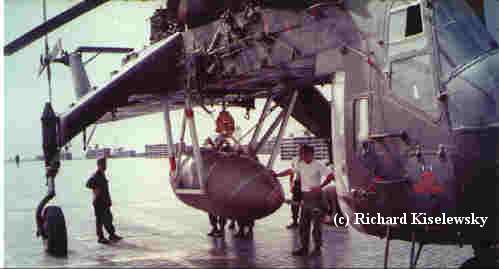 |
ARMY HH-60 "BOMBER"
Below is a photograph of an Army HH-60 parked on the ramp at Phu Bai on or about May 12, 1968 It was carrying a 15,000 lb bomb which (in theory) when dropped would create an instant landing zone (LZ) for helicopters if the tactical situation required its use.
The bomb loaded on the HH-60 was rigged with two 36 inch long "daisy cutters" (total 6' long). Normally the fixed wing version of a "daisy cutter" was an 18" steel pipe which contained a sleeve of explosive, normally Composition B, which was screwed into the booster in the nose of the bomb. The intent of the design was to cause the bomb to burst at ground level and send shrapnel out in an expanding circle from point of impact thus the name "daisy cutter". For fixed wing delivery the pipe could be extended by adding additional lengths but was not normally more than 36" in length. Thus the "daisy cutter" shown here was two or more times as large as the fixed wing delivered ordnance.
I was an ordnance man ( MOS 6511) and was interested in it's configuration. As can be seen, the bomb lacked a tail fin assembly but used instead a parachute to keep the bomb in a nose down configuration. I remember remarking at the time that such a rig would cause problems with wind drift and make accurate delivery unlikely. Later in the war I learned that was just the case and they stopped using them.
I read other accounts that during the "Easter Offensive"
of 1972 the Republic of Vietnam used the bombs by rolling them out
of C-130's with excellent results. This time they were proven to
be extremely effective against troops. Their use not only resulted
in large numbers of casualties but also had obvious psychological consequences.
 |
Information provided by:
Richard Kiselewsky, former Sgt.
USMC
(Squadron Armor, Gunner and Aircraft
Recovery Team)
Next '68 Page or Album Index or Home
LAST UPDATED: AUGUST 17, 1999